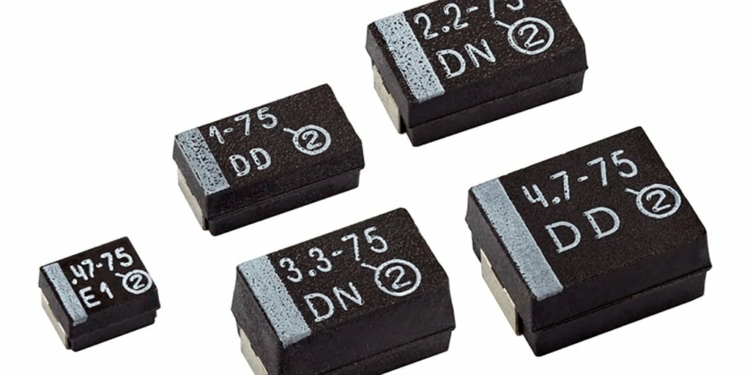Source: Electronic Products article
Low-ESR tantalum capacitors can improve circuit power efficiency, reduce heat generation for the circuit, and increase low-term reliability.
By Charles Pothier, vice president of marketing, Tantalum Capacitor Division, Vishay Intertechnology
When choosing a capacitor for any application, there are a few key characteristics that must be understood in order to analyze its suitability for the circuit. In a simple capacitor equivalent circuit model, there are three key characteristics that affect circuit performance: capacitance, equivalent series resistance (ESR), and inductance. The magnitude of these elements — and how they change over temperature, frequency, and applied voltage — are different for each capacitor technology.
In this technical note, we will examine the ways in which ESR in tantalum capacitors affects circuit performance. ESR is the sum of all of the purely resistive contributors to the capacitor’s impedance. As such, it is the characteristic that creates losses due to heating. It also affects the magnitude of charge and discharge currents as the capacitor does its work
In a solid tantalum capacitor, the components that contribute to ESR are the resistivity of the:
- Solid electrolyte system (MnO2)
- Dielectric layer (Ta2O5)
- Terminations, lead frames, and other elements that provide connection to the PCB
Solid tantalum capacitor manufacturers can make improvements in physical design and materials that reduce the overall ESR of the capacitor. These lower-ESR capacitors will lead to reductions in heat generation within the capacitor, thus improving overall circuit efficiency and long-term reliability. Reductions in ESR will also improve the capacitor’s ability to supply higher currents during charge and discharge cycles to improve circuit performance. Typical impedance (Z) and ESR data for a range of popular values are shown in Fig. 1.

Fig. 1: Typical impedance (Z) and ESR data for a range of popular values.
Two primary functions that tantalum capacitors are ideally suited for are bulk energy storage and waveform filtering.
Bulk capacitance
In addition to maximum working voltage and voltage derating, an important characteristic of any capacitor is its ability to store an electrical charge. Some applications require the capacitor to store large amounts of charge.
Solid tantalum devices are well-suited for bulk energy storage due to their high and stable capacitance values and are widely used to hold up voltage rails during times of peak current demand. Here, two factors must be considered. The first is the total capacitance required to supply the required energy for the necessary time. In some cases, a single tantalum capacitor is sufficient, but in more demanding applications, multiple capacitors may be configured in parallel so that their capacitance values are cumulative and the combined resistance of the array is reduced. The second factor is the ESR of the capacitors. Lower ESR results in higher deliverable current levels and lower voltage drop during discharge for improved circuit performance.
An example is the bulk capacitance required on a 3.3-V rail that supplies power to a microprocessor. During turn-on, and in the application when processing demands are high, the microprocessor will have high current demands that must be satisfied. The ability of the capacitors to effectively deliver this bulk energy is often characterized with a specification called the “slew rate,” which is defined as “idle current” to “peak current” with a specified slope “A/µs.” During times of peak demand, it may be necessary to keep the rail voltage within a required specification range (for example, a drop of less than 10% = 0.33 V). Capacitors with lower ESR can provide higher discharge currents with reduced heat generation to meet these demands more quickly and efficiently.
Designers may actually place several lower-capacitance multilayer ceramic capacitors (MLCCs) close to the processor for short-term current supply and then add larger bulk storage capacitors (tantalum, polymer, or aluminum electrolytic devices) slightly farther away to meet longer-term current demands. The ultra-low ESR of the MLCCs allows for very high instantaneous currents, but their limited capacitance means that they are able to supply the required current for only a short period of time. After that time, the bulk capacitors can take over and meet required circuit demands. When lower-ESR tantalum capacitors are used in this application, there is less reliance on the MLCCs and fewer of them are required. This saves PCB board space as well as component costs. They also improve board-level reliability with their more rugged construction.
Another advantage of using low-ESR tantalum devices as bulk energy capacitors is reduced heat generation during charge/discharge cycles. This improves circuit power efficiency and results in a lower operational temperature for the circuit. It may also allow for the use of smaller power supplies for further cost savings. Low ESR capacitors are available in a number of case sizes.
Waveform filtering
When low-ESR capacitors are used for smoothing a signal, they reduce the amount of ripple current that appears on the DC bus, such as output filter capacitors in switch-mode power supplies (SMPS). This is accomplished by allowing for higher charge/discharge currents to better follow the voltage cycles and supply energy during any peaks and valleys in the waveform. As the ripple current (peak to peak) is reduced, less heat is dissipated on each charge/discharge cycle. Lower-ESR (and lower-inductance) capacitors also allow ripple filter capacitors to be used effectively in circuits with higher-frequency AC noise components.
Consider the Vishay TR3 low-ESR product line. The TR3’s best-in-class ESR yields improved circuit electrical performance, power efficiency, and reliability (lower operating temperatures). Based on case size, a number of capacitance/voltage (CV) options are available and each combination has a specific ESR value (see Fig. 2 for the D case example).

Fig. 2: Capacitance/voltage options with ESR values for Vishay’s TR3 low-ESR tantalum capacitors.
In addition to ESR, designers must take voltage rating, ESL, DCL, and dielectric properties into consideration for filter capacitor designs. Tantalum capacitors in general allow for very low-profile and compact designs and enable high PCB-level reliability due to their solid construction.
About the author
Charles Pothier currently serves as the vice president of marketing for Vishay’s Tantalum Capacitor Division. He has previously held the positions of marketing manager at Teradyne and electrical engineer for Lockheed Martin. Mr. Pothier holds a B.S. in electrical engineering from Northeastern University and an M.S. in administration from Boston University.


































